A sprouting lesson:
you’ve already got
what it takes
November 18, 2006
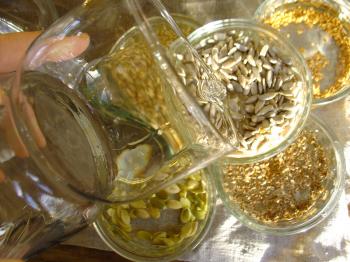
Counter-top sprouting installation chez culiblog
When I remind my guests at the Grow Yer Own Dang Food micro-green cuisine concept restaurant that eating seasonal, local food is one of the most revolutionary actions that you can take against petrol consumption, right fists usually fly straight into the air and throaty cries of Right On, Sister resonnate loud and clear.
But when I explain that even without land, right here in our urban interiors, we can all easily grow fresh, organic vegetables (also in the light-deprived Polar Circle), I am most often confronted with the slack-jawed stare of disbelief. Since the restaurant’s opening, I have received copious requests to give a tutorial on sprouting. Thankfully, the servant is the master.
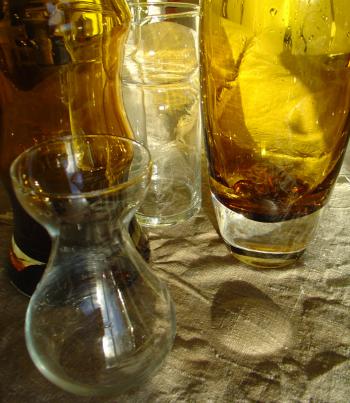
Start by using what you’ve already got. But wash it.
Equipment: pretty is as pretty does
Although many a sprouting friend swears by her stacked sprouting trays, and others can’t imagine indoor farming without their sprout bags, intimi know that culiblog is a proponent of vernacular design and playful ad hocism.
No need to buy product when your cut glass tumblers and jam jars will work just fine. Pretty wide-mouthed vases or recycled yoghurt pots, you can make an ikebana installation with the sprouted vegetation and install it as a centrepiece on your dining table. For as with people, so also with sprouting; the prettier something is, the more likely you are to do it, if you know what I mean. Use beautiful vessels and work with what you’ve got.
For sprouting mucilagenous seeds (slimey) like mustard, watercress and basil, you don’t need to buy, sew or handloom a sprout bag when a cotton tea towel or linen napkin draped over a plate will do. You’ve already got everything it takes to sprout.
Equipment list:
- something to sprout (seed)
- something to sprout in (vessel)
- something to sprout on (fabric)
- sieve (for decadent rinsing)
Ingredients:
- seeds
- water
Here’s the recipe:
seeds + water + time = sprouts
A more detailed version of the same recipe would read:
seeds + water + time + darkness + water + time + water + time + natural light = sprouts
Sprouting lesson in 4 steps:
1. Soak the seeds in water for one night.
2. In the morning, drain off the excess water and rinse the seeds with fresh water, either by swirling them around in the vessel, or by pouring them into a sieve. Return the wet seed to the vessel and place in a dark place.
3.Keep the seeds in the dark for 2-4 days, removing them twice a day for rinsing.
4. After 2-4 days (depending on the amount of growth) you can bring the baby sprouts into the light. I like to switch to a fresh vessel at this point, but that’s only because I’m a show-off and use the sprout-filled vessels in flower arrangments.
Every now and again, taste your crop. If you think it’s done, you can choose to put the sprouts in the fridge, covered with a damp tea towel.
The only difficult part about sprouting is developing a rhythm of eating and starting a new crop - that’s just like gardening. It takes 4-10 days to sprout the sorts of seeds you would likely want to eat as sprouts.
Grow sprouts that you can’t easily buy for next to nothing from the farmer’s market. At the moment I’m really into sunflower, pumpkin seed and fenugreek sprouts.
debra at 23:47 | | post to del.icio.us

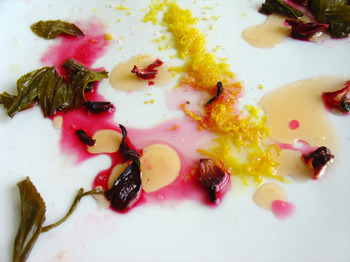
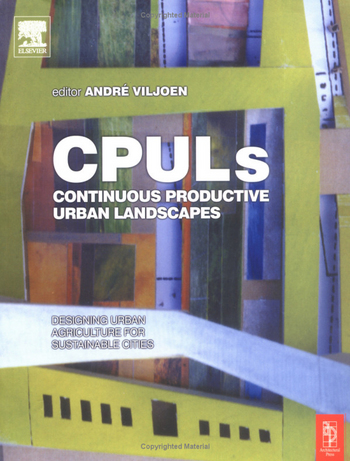
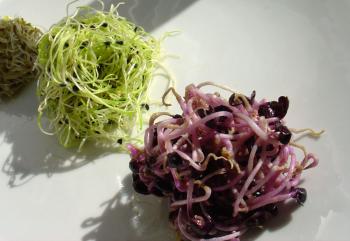
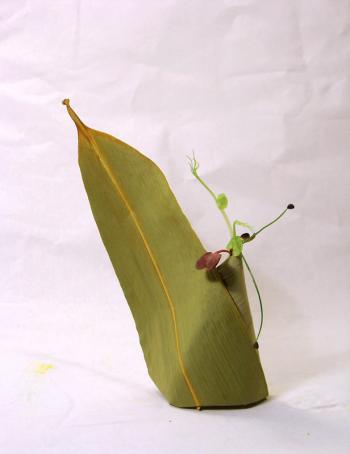










Hey, I’ve been looking all over the internet and can’t find what to do with my pumpkin seed. The thing is, I was collecting all the seeds from my carved pumpkin and there was a seedling that had already began to sprout, you can see a little leaf stuck in the seed hull. I would love to eventually grow it into a pumpkin plant, but I don’t know what to do with the seed before it dies on me! Right now I just put it in water, but if you have any advice at all for me, I’d GREATLY appreciate it!! =)
~Forest
Comment by Forest — October 29, 2007 @ 0:54
You rinse with wate twice a day, no soak after its sprouted.
Comment by Bling — October 7, 2008 @ 17:36